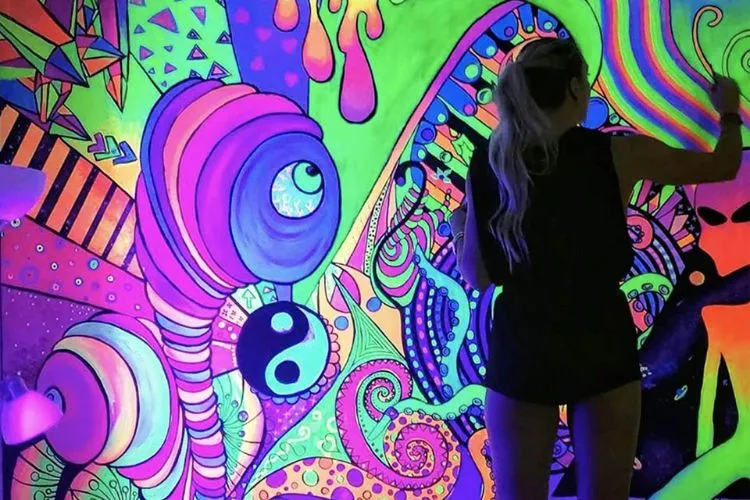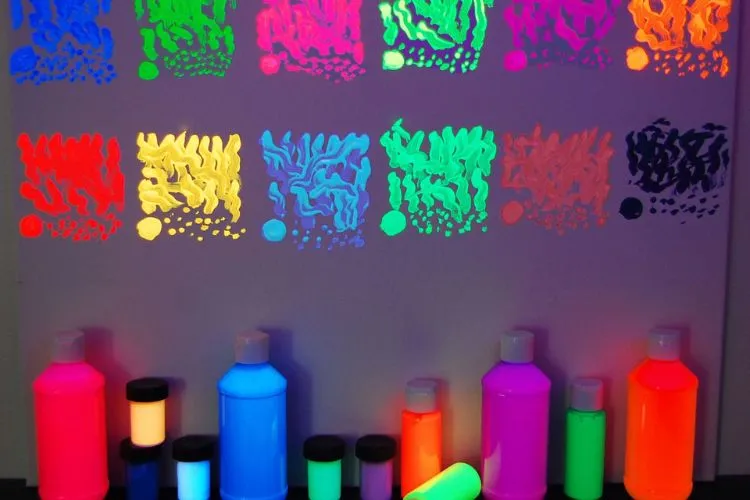Art enthusiasts and creative individuals are often drawn to the luminous allure that accompanies glow-in-the-dark features in artworks and decorations.
An intriguing question that arises within such artistic circles is whether acrylic paint, a staple medium in numerous art projects, possesses the ability to glow under blacklight.
This article delves into the world of acrylic paints and their interaction with blacklight, providing insights into how to enhance your artistic endeavors with glowing effects.

Understanding Blacklights
To unravel the mystery of glowing paint, we must first comprehend what blacklight is. Unlike everyday lighting that emits a broad spectrum of visible light, blacklights emit ultraviolet light.
This type of light remains largely invisible to the naked eye, but it can cause certain materials to fluoresce or phosphoresce, which in turn makes them appear to glow.
When exposed to ultraviolet light, fluorescent materials absorb the light and then re-emit it almost instantaneously.
On the other hand, phosphorescent materials absorb and store the energy for a while before slowly re-emitting it, which leads to a lingering glow even when the light source is turned off.
Overview of Acrylic Paints
Acrylic paints are cherished by artists due to their versatility, quick drying times, and ease of use. Comprising pigments suspended in an acrylic polymer emulsion, these paints are water-soluble but become water-resistant when dry.
The formulation of acrylic paints does not naturally include glowing components; however, certain varieties contain fluorescent materials that have the potential to glow under blacklight.
Does Acrylic Paint Glow In Blacklight?
The relationship between standard acrylic paints and blacklight is not as straightforward as one might hope. Most regular acrylic paints do not inherently glow under blacklight.
The glow typically occurs when the paint contains a fluorescent component designed to react to the ultraviolet rays emitted by the blacklight.
A selection of acrylic paints in the market is specifically formulated to respond to blacklight. These specialized paints contain fluorescent pigments that capture and re-emit light from the blacklight, creating the desired glowing effect.
These formulas are often available in a range of vibrant colors, each capable of producing a distinct fluorescent glow.
How to Make Acrylic Paint Glow in Blacklight?
If you are working with standard acrylic paint and aiming for a glow under blacklight, there is a creative solution at your disposal. Mixing a fluorescent medium into your acrylic paint can transform it into a blacklight-sensitive concoction.
Art supply stores often offer these mediums, along with ready-to-use fluorescent or glow-in-the-dark acrylic paints that save you the mix-and-match effort.

Furthermore, it is essential to consider that while clear mediums can be added to the majority of acrylic paints without affecting their base color, they will alter the way the paints react to blacklight.
The end result may vary depending on the quality of the medium and the paint used, so experimentation is key.
Creative Project Ideas Using Glowing Acrylic Paint
The combination of acrylic paints and blacklight can lead to a multitude of exciting art projects and decorations. For instance, you can use glowing paints to add an ethereal touch to cosmic-themed paintings, enhancing the otherworldly atmosphere.
Moreover, event planners might use these paints for vivid posters and signs that pop under blacklight, adding a dynamic edge to dance parties or neon-themed events. Educators can also employ glowing paints to make learning about light and color more engaging for students.
You may also read: Does Acrylic Paint Fade In Sunlight? | Does Acrylic Paint Yellow Over Time?
Maintenance and Safety Tips
When engaging with glowing acrylic paints, it’s crucial to follow best practices for use and storage. Always ensure that your paints and other materials are sealed properly when not in use, as this will prolong their lifespan and maintain their glowing properties.
Store your paints away from direct sunlight and in a cool, dry place to prevent the degradation of the fluorescent pigments.
It’s also vital to adhere to safety precautions when using blacklight and fluorescent materials. Although blacklights are generally safe, prolonged exposure to ultraviolet light should be avoided.
When working on your projects, do so in a well-ventilated area and consider wearing protective eyewear to shield your eyes from intense blacklight radiation.
Exploring the Spectrum: Types of Glow Effects in Paint
In the world of art and decoration, paints can be engineered to produce a variety of glow effects—each offering a distinct visual experience. Neon paints provide intensely vivid, saturated colors that stand out vibrantly even in daylight.
Fluorescent paints take this a step further; they emit a powerful glow when exposed to blacklight due to their ability to absorb and re-emit light in the visible spectrum.

Phosphorescent paints, commonly known as “glow-in-the-dark,” absorb light energy and slowly release it, giving a magical afterglow effect once the light source is removed.
Lastly, luminescent paints encompass both fluorescent and phosphorescent properties and can be tailored through various mediums to achieve the desired degree of glow and duration of effect.
These special paints and mediums can be used to heighten the sensory impact of artistic works and practical applications alike.
Frequently Asked Questions (FAQs)
Does any acrylic paint glow under blacklight?
Not all acrylic paints will glow under blacklight. Only those containing fluorescent pigments will respond to the UV light and glow.
How can I make my acrylic paint glow?
One can either purchase fluorescent acrylic paints or mix standard acrylic paint with a fluorescent medium to make them glow under blacklight.
Are there safety concerns when using glowing paint or blacklight?
As with any art material, it’s essential to use glowing paint safely. Blacklights emit UV light, and while not harmful in small doses, proper precautions, such as working in a well-ventilated area and using protective eyewear, should be taken.
Conclusion:
Throughout this exploration, we have learned that while standard acrylic paint does not naturally glow under blacklight, there are specific types imbued with fluorescent pigments that do.
By incorporating either premade glowing paints or by creating your own mixture with fluorescent mediums, a whole new dimension of artistic expression becomes accessible.
As you embark on your journey to make art that truly shines, remember to adhere to safety guidelines and let your creative instincts guide you through the use of glowing paint under blacklight.

Meet Isabella Anderson, your acrylic painting mentor with over a decade of brush-wielding mastery. Dive into the colorful world of acrylics with her expert guidance, featured exclusively on ‘Acrylic Authority.’ Unleash your inner artist and explore the limitless possibilities of this versatile medium alongside a true acrylic aficionado.
